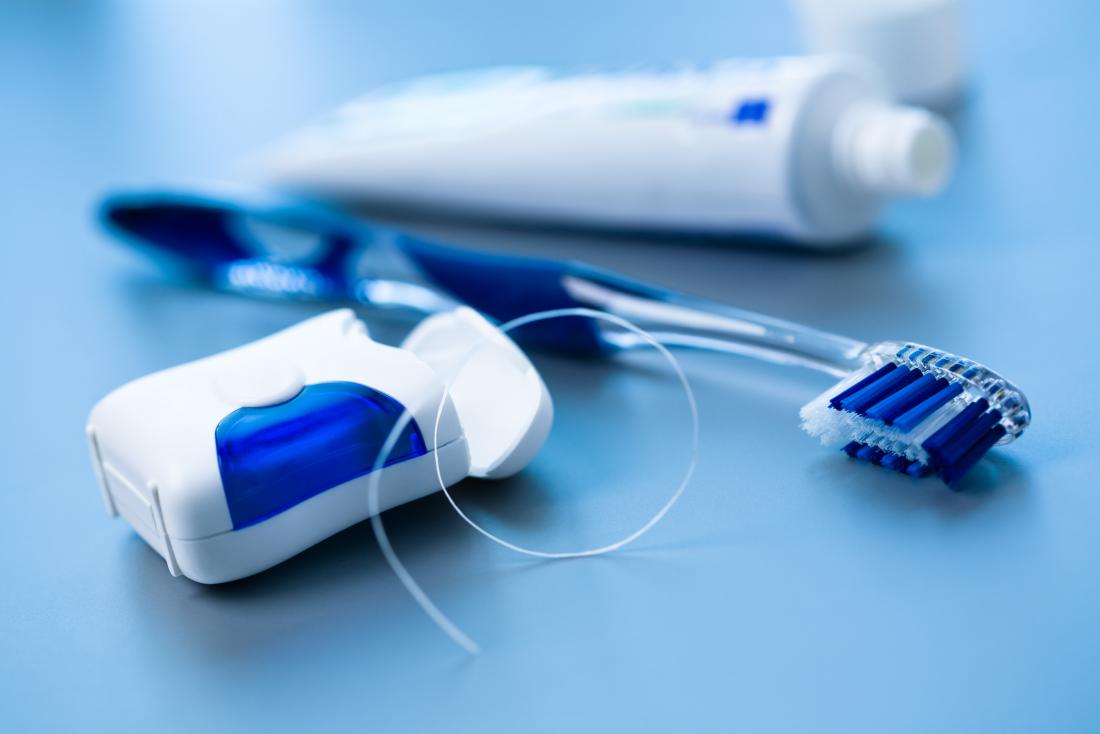However, oral health is about more than cavities and gum disease. Research has shown that there is an association between the health of a person’s mouth and their overall health. Experts consider oral health problems to be a global health burden.
Without treatment, tooth decay or gum problems can lead to pain, problems with self-confidence, and tooth loss. These issues may lead to malnutrition, speech problems, and other challenges in a person’s work, school, or personal life.
People can prevent these problems with proper dental care, both at home and in the dentist’s office. The following are some best practices that can keep teeth and gums healthy.
1. Brush regularly but not aggressively

Brushing twice a day and using dental floss can help keep teeth and gums healthy.
Most people are aware that brushing their teeth twice a day is one of the most important practices for removing plaque and bacteria and keeping teeth clean. However, brushing may only be effective if people use the correct technique.
People should brush using small circular motions, taking care to brush the front, back, and top of every tooth. This process takes between 2 and 3 minutes. People should avoid sawing back-and-forth motions.
Brushing too hard or using a hard-bristled toothbrush can damage tooth enamel and the gums. The effects of this may include tooth sensitivity, permanent damage to the protective enamel on the teeth, and gum erosion.
The American Dental Association (ADA) recommend using a toothbrush that has soft bristles. They also state that people should change their toothbrush every 3 months or when the ends start to look frayed, whichever comes first.
2. Use fluoride
Fluoride comes from an element in the earth’s soil called fluorine. Many experts believe that fluoride helps prevent cavities, and it is a common ingredient in toothpaste and mouthwash.
However, some dental products do not contain fluoride, and some people do not use it at all.
Evidence suggests that a lack of fluoride can lead to tooth decay, even if a person takes care of their teeth otherwise. A recent review found that brushing and flossing do not prevent a person from getting cavities if they do not use fluoride.
Many communities in the United States have added fluoride to their water supply. Several organizations recommend this practice, including the World Health Organization (WHO), the Centers for Disease Control and Prevention (CDC), and the ADA.
People can find out whether the water in their area contains fluoride by contacting their local government. Reverse osmosis water filters remove fluoride, and people who use well water will need to check the fluoride levels in this water to find out how much is present. Many bottled water brands do not contain fluoride.
3. Floss once a day
Flossing can remove plaque and bacteria from between the teeth, where a toothbrush is unable to reach. It can also help prevent bad breath by removing debris and food that has become trapped between the teeth.
Although there is a lack of long-term studies proving that flossing is beneficial, the ADA continue to recommend it. The CDC also state that people should floss their teeth.
Most dental health professionals recommend gently pushing the floss all the way down to the gumline before hugging the side of the tooth with up-and-down motions. It is important to avoid snapping the floss up and down between the teeth, which can cause pain and will not remove plaque as effectively.
4. See a dentist regularly

A dentist can diagnose and treat oral health issues before they become severe.
Experts recommend that people see a dentist every 6 months for a checkup. During a routine dental examination, a hygienist will clean the teeth and remove plaque and hardened tartar.
The dentist will check for visual signs of cavities, gum disease, mouth cancer, and other oral health issues. They may sometimes also use dental X-rays to check for cavities.
The results of a recent study confirmed that children and adolescents should see a dentist every 6 months to help prevent cavities. However, adults who practice good dental hygiene every day and have a low risk of oral health problems may be able to go less frequently.
The authors of a recent review state that there is a need for more high-quality studies to confirm the ideal frequency of dental checkups.
People can speak to their dentist about how often they need a checkup. The answer may vary depending on a person’s health history, age, and overall dental health. However, anyone who notices changes in their mouth should visit a dentist.
5. Do not smoke
Smoking harms the body’s immune system, which makes it difficult for the body to heal tissues, including those in the mouth. The CDC name smoking as a risk factor for gum disease, while the ADA warn that people who smoke may experience slow healing after a dental procedure.
Smoking also affects the appearance of the mouth, leading to yellowing of the teeth and tongue, and it can give breath a bad odor.
6. Consider a mouthwash
Some studies indicate that certain mouthwashes can benefit oral health. For example, one review found that mouthwash containing chlorhexidine, an antibacterial ingredient, helps control plaque and gingivitis. Mouthwashes with certain essential oils are also effective, according to a meta-analysis.
People may wish to ask their dentist which is the best mouthwash for their individual needs. A mouthwash cannot substitute brushing and flossing, but it can complement these practices.
Mouthwashes that may help with bad breath and dental problems are available online.
7. Limit sugary foods and starches
Consuming sugar can lead to cavities. Studies continue to highlight the significant role that sugar plays in adverse dental health outcomes. Common culprits include candy and desserts, but many processed foods also contain added sugar.
The WHO recommend that people limit their intake of sugar to below 10 percent of their daily calories. The authors of a systematic review concluded that lowering this to 5 percent would further reduce the risk of cavities and other dental problems.
Experts have also stated that starchy foods, such as crackers, bread, chips, and pasta, can cause tooth decay. The ADA explain that these foods linger in the mouth and break down into simple sugars, on which acid-producing bacteria feed. This acid can cause tooth decay.
Instead of starchy foods, the ADA recommend eating plenty of fiber-rich fruits and vegetables as well as dairy products without added sugar.
8. Drink water instead of sugary drinks
Sugar-sweetened beverages are the number one source of added sugars in the typical diet of those in the U.S. Sipping on soda, juice, or other sugary drinks can lead to a higher risk of cavities.
The ADA recommend drinking water or unsweetened tea throughout the day and only drinking sugar-sweetened drinks at meal times and in small volumes.
Tips for kids

Teaching good dental hygiene can help ensure a child’s teeth and gums remain healthy as they grow up.
A child’s primary teeth, which people sometimes call baby teeth, are just as important as their permanent teeth. Baby teeth help a child chew and speak. They are placeholders for the future permanent teeth.
If a child loses a baby tooth to decay, this can disrupt the space in the mouth and make it difficult for the adult tooth to develop correctly.
With this in mind, it is best to introduce good dental care for children during infancy. The following practices will help keep a child’s teeth and gums healthy:
- Wipe a baby’s gums with a warm, wet washcloth every day, even before they have any teeth. Doing this removes sugars from the gums and can help a baby become familiar with the feeling of cleaning their teeth.
- Babies and toddlers should not go to bed with bottles or sippy cups. Milk and juice contain sugars that can cause tooth decay if they remain on the teeth for extended periods.
- As a baby approaches 1 year of age, start getting them used to a sippy cup. Aim to stop using bottles by their first birthday.
- Allow toddlers to sip water from sippy cups between meals, but save juice or milk for meal times only.
- Once a baby has teeth, brush them twice a day with a soft baby toothbrush. Use a tiny amount of fluoride toothpaste, no bigger than a grain of rice. Children who are 3 to 6 years of age may use a pea-sized amount of toothpaste.
- Parents or caregivers should brush the child’s teeth for them until they can clean all of their teeth thoroughly without help. Monitor them to make sure that they spit out the toothpaste.
- Keep the toothpaste out of children’s reach when it is not in use.
- The ADA recommend that children see a dentist within 6 months of their first tooth appearing or at 1 year of age, whichever comes first.
- Parents and caregivers should not share eating utensils with a child or clean pacifiers by putting them in their mouth. Both of these actions can pass the adult’s cavity-causing bacteria to the child.
Summary
Practicing good dental care from infancy to adulthood can help a person keep their teeth and gums healthy. Brushing and flossing daily, not smoking, eating a healthful diet, and having regular dental checkups can help people avoid cavities, gum disease, and other dental issues. It may also benefit their overall health.
